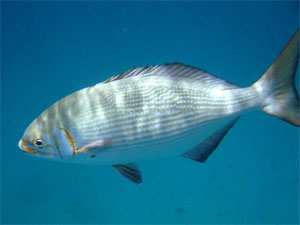U.S. fishing bycatch wastes 1 million metric tons of fish per year says study
Oceana release
December 1, 2005
A new study shows that for every five pounds of fish caught by U.S. commercial fisheries, one pound is dumped dead, dying and wasted. Each year, U.S. commercial fishing operations throw away more than one million metric tons of fish, an amount equivalent to 28 percent of all commercial landings and more than all of the fish landed on the East and West coasts combined.
The Gulf of Mexico shrimp fishery ranked worst of all, discarding more than 472,000 metric tons, or one billion pounds of fish, nearly half of the total waste in U.S. fisheries.
“At a time when the United States is struggling to restore its valuable commercial fisheries, this sort of waste undermines efforts to recover those depleted resources,” said author Dr. Andrew Rosenberg of the University of New Hampshire and a member of the White House-appointed U.S. Commission on Ocean Policy. “We can and should do better, not just by describing the problem, but by taking the steps needed to reduce wasteful fishing practices.”
The study, Wasted Resources: Bycatch and Discards in U.S. Fisheries [PDF], is the only comprehensive review of dirty fishing or bycatch fish that are caught but dumped overboard because they are not wanted or cannot be kept in American fisheries. Oceana commissioned the study, which is being published in the December issue of the respected scientific journal Fish and Fisheries. It was conducted by Rosenberg, marine scientist Dr. Ransom A. Myers of Dalhousie University, Nova Scotia, and Jennie Harrington of Marine Resources Assessment Group.
 Related articles Fish threatened by climate change November 18, 2005 FDA warning on mercury in fish may be misleading consumers August 1, 2005 Free floating fishing nets kill marine mammals, turtles and sea birds May 4, 2005 Where are the fish? Ocean fisheries in trouble May 3, 2005 |
“When a quarter of everything that is caught is wasted, there will be impacts on the overall health of the oceans,” said Dr. Myers, named in Fortune magazine’s October 2005 issue as one of the world’s top ten people to watch, because of his landmark study that found that 90 percent of the oceans’ “big” fish, like tuna and marlin, have disappeared since the 1950s. “We hope this study wakes up fishery managers to the fact that broad-based action covering all U.S. fisheries is needed to address this problem.”
The study also found that trawl fisheries overwhelmingly account for the discards in U.S. fisheries. The shrimp and fish trawl fisheries are responsible for 78 percent of all discards in U.S. fisheries. The study lists the 12 worst fisheries for discards by weight and by ratio of discards to landings, and most are trawl fisheries that target groundfish species.
“This study demonstrates that the United States is as bad as or worse than the rest of the world’s top fishing nations when it comes to waste,” said Dr. Michael Hirshfield, chief scientist and senior vice president for Oceana. “The United States needs to clean up its act and stop this dirty fishing, as it is required to do by laws passed more than a decade ago.”
The study was conducted using the most recent data publicly available for all federally managed fisheries in the United States. The findings are based on data for 2002 and 2003, with the exception of the Atlantic highly migratory species fishery, for which the most recent available data is from 2001.
Read the Fish and Fisheries Journal Report
This story is derived from an Oceana. This original version appears at Leading Scientists Andrew Rosenberg, Ransom Myers Reveal.